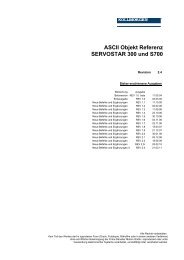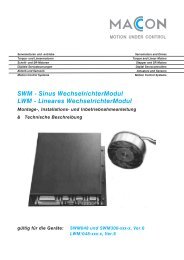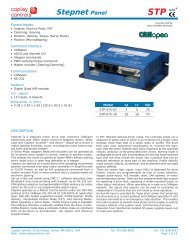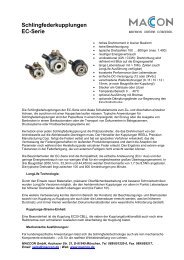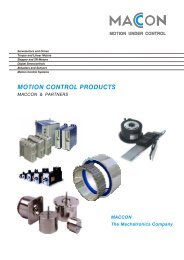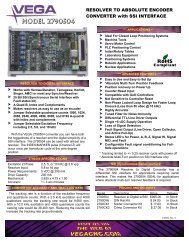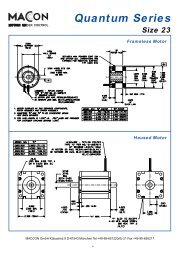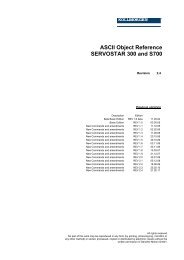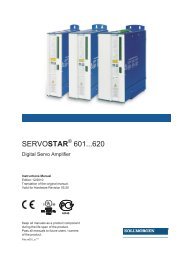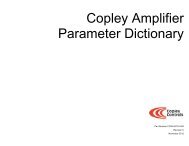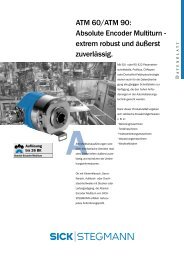CANopen Programmer's Manual - Maccon.de
CANopen Programmer's Manual - Maccon.de
CANopen Programmer's Manual - Maccon.de
You also want an ePaper? Increase the reach of your titles
YUMPU automatically turns print PDFs into web optimized ePapers that Google loves.
<strong>CANopen</strong> Programmer’s <strong>Manual</strong> 3: Device Control, Configuration, and Status<br />
CANOPEN NETWORK CONFIGURATION INDEX 0X21B0<br />
Type Access Units Range Map PDO Memory<br />
Unsigned 16 RW - See Description, below. NO RF<br />
Description<br />
This object is used to configure the <strong>CANopen</strong> network bit rate and no<strong>de</strong> ID for the amplifier.<br />
The bit rate is read only at power-up or reset.<br />
Likewise, the ID is calculated at power-up or reset (and only then) using a combination of generalpurpose<br />
input pins and a programmed offset value. On certain mo<strong>de</strong>ls, an address switch is also<br />
used. The resulting value is clipped to a 7-bit ID in the range 0 to 127.<br />
The configuration parameter is bit-mapped as follows. Values written here are stored to flash<br />
memory. The new network configuration will not take effect until the amplifier is reset.<br />
Bit Description<br />
0-6 Give the no<strong>de</strong> ID offset value.<br />
7 Used only on DeviceNet firmware. If this bit is set, then the drive will be software disabled on startup and will<br />
remain disabled until it is enabled by a DeviceNet I/O message with the enable bit set.<br />
8-10 Number of input pins (0-7) to read on startup for the no<strong>de</strong> ID value. If input pins are used (i.e., the value in<br />
bits 8-10 is not zero), the inputs can be mapped to no<strong>de</strong> ID bits through the object Input Mapping for CAN<br />
No<strong>de</strong> ID (in<strong>de</strong>x 0x21B1, p. 78).<br />
11 This bit is ignored on amplifiers that do not have an address switch.<br />
On amplifiers with an address switch, setting this bit programs the amplifier to use the address selector<br />
switch as part of the address calculation. In this case, the no<strong>de</strong> ID value is equal to the sum of:<br />
The value read from the <strong>de</strong>signated input pins, shifted up 4 bits.<br />
The address switch value.<br />
The programmed offset value.<br />
Note that since the no<strong>de</strong> ID is always clipped to the lowest 7 bits, no more than 3 input pins will ever have<br />
an effect on the no<strong>de</strong> address when the address switch is used.<br />
12-15 Network bit rate setting.<br />
The network bit rate is enco<strong>de</strong>d as one of the following values:<br />
Co<strong>de</strong> Bit Rate (bits / second)<br />
0 1,000,000<br />
1 800,000<br />
2 500,000<br />
3 250,000<br />
4 125,000<br />
5 50,000<br />
6 20,000<br />
7-15 Reserved for future use<br />
Copley Controls 77




